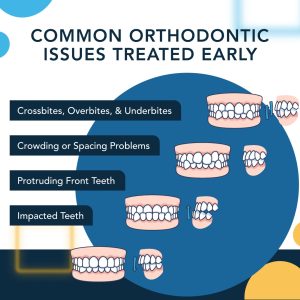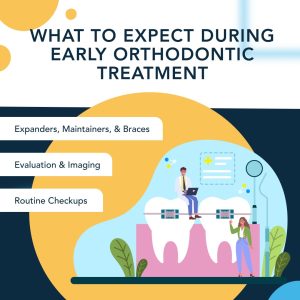As children grow, so do their smiles, and early orthodontic treatment can play a crucial role in making sure those smiles develop properly. While many people associate braces with teenagers, orthodontic care often starts much earlier. In fact, beginning treatment in childhood can help guide jaw growth, prevent more serious problems, and even shorten the time spent in braces later on.
In this article, we’ll explore what early orthodontic treatment is, why it matters, and how it can set your child up for a lifetime of healthy, confident smiles. Whether you’re just starting to notice alignment issues or have been referred to an orthodontist, understanding the process can help you make informed decisions about your child’s dental health.
What Is Early Orthodontic Treatment?
Early orthodontic treatment (also known as interceptive orthodontics) focuses on identifying and addressing dental or jaw issues in children before all of their permanent teeth come in. Rather than waiting until adolescence, treatment may begin as early as age 6 or 7, while the child’s mouth and jaw are still developing. This proactive approach can help prevent minor issues from becoming more complex and often leads to better long-term outcomes.
Understanding Phase 1 and Phase 2 Treatment
Orthodontic treatment for children is often divided into two distinct phases: Phase 1 and Phase 2. This two-phase approach allows orthodontists to guide jaw and tooth development early, then fine-tune the smile once all permanent teeth are in. Understanding how each phase works helps parents see the full picture and long-term benefits of early intervention.
Phase 1 Treatment
Phase 1, also called interceptive treatment, typically begins while a child still has a mix of baby and permanent teeth. The main goal of Phase 1 is to address significant developmental issues early, such as jaw growth problems, bite misalignment, or space issues, that could become more severe if left untreated.
Common treatments during Phase 1 include:
- Palatal expanders to widen the upper jaw
- Space maintainers to prevent crowding
- Partial braces for front teeth
- Habit appliances to stop thumb-sucking or tongue thrusting
Phase 2 Treatment
Phase 2 begins once all permanent teeth have come in, usually between the ages of 11 and 13. At this stage, full braces or clear aligners are used to straighten the teeth, close any gaps, and fine-tune the bite for long-term function and aesthetics.
Because many foundational issues were already addressed in Phase 1, Phase 2 is often shorter and more effective than it would be without early intervention. This phase helps complete the smile transformation and ensures long-lasting results.
Typical Age Range for Early Intervention
Most orthodontists recommend that children have their first orthodontic evaluation around age 7. At this age, a professional can assess how the teeth, jaw, and bite are developing, even if no visible problems are present.
Early evaluation doesn’t always mean early treatment, but it allows for careful monitoring and timely intervention if necessary. Every child is different, and an experienced Davie dentist or pediatric orthodontist will recommend the best approach based on your child’s unique needs and growth patterns.
Why Timing Matters: The Case for Early Evaluation
Orthodontic problems don’t always announce themselves with obvious symptoms. In many cases, issues with jaw development, bite alignment, or crowding are developing silently beneath the surface. That’s why early evaluation is essential, as it allows orthodontists to catch problems early, when they’re easiest to correct.
Starting the process at the right time can often reduce or eliminate the need for more invasive treatments later in life. It also gives your child the best chance at a healthy, confident smile with fewer complications along the way.
American Association of Orthodontists Recommendations
The American Association of Orthodontists (AAO) recommends that every child have their first orthodontic screening by age 7. By this age, most children have a mix of baby and permanent teeth, making it easier for orthodontists to spot problems with tooth positioning, bite function, and jaw growth.
This doesn’t mean every child will need braces right away, but it allows your orthodontist to create a personalized plan based on your child’s development. In some cases, a “wait and watch” approach may be recommended, while in others, interceptive treatment can begin early for better long-term results.
Monitoring Growth and Development
Children’s mouths change rapidly as they grow. Regular orthodontic check-ins allow providers to monitor how the teeth are erupting and how the jaw is forming. With early evaluations, orthodontists can track spacing, crowding, alignment, and bite patterns over time and respond proactively if a problem begins to develop.
This growth-based approach is especially useful in preventing problems from worsening. It also allows for treatment to be timed in sync with natural growth spurts, which can improve results and reduce the amount of time spent in braces later.
Identifying Hidden or Emerging Issues
Not all orthodontic issues are visible to the untrained eye. A child may have impacted teeth, an underdeveloped jaw, or a misaligned bite that won’t become obvious until it’s much harder to treat. Early orthodontic evaluations, often supported by X-rays or digital imaging, can reveal these hidden or emerging problems before they lead to discomfort or functional issues.
By identifying and addressing these concerns early, parents can often avoid more complex procedures like tooth extractions, jaw surgery, or extensive orthodontic correction in the teen years.
Common Orthodontic Issues Treated Early
Early orthodontic treatment is often focused on correcting developmental issues that can interfere with proper jaw alignment, tooth eruption, and bite function. When these problems are identified and treated early, it can reduce the need for more intensive procedures down the road and support a healthier, more functional smile as your child grows. Here are some of the most common orthodontic issues addressed through early intervention:
Crossbites, Overbites, and Underbites
These bite issues occur when the upper and lower teeth don’t come together properly. If left untreated, these misalignments can lead to uneven tooth wear, jaw strain, speech difficulties, and facial asymmetry. Early treatment can help guide the jaw into proper alignment while it’s still growing.
Crowding or Spacing Problems
When there’s not enough room in the mouth, teeth can become crowded or overlap one another. In contrast, excess spacing may occur when teeth are too far apart, often due to missing teeth or differences in jaw size. Early orthodontic intervention, such as using expanders or space maintainers, can help guide the development of the jaw and ensure that permanent teeth have the space they need to come in correctly.
Protruding Front Teeth
Front teeth that stick out too far (often due to thumb-sucking, tongue thrusting, or jaw imbalance) not only affect the look of your child’s smile but also increase the risk of dental trauma. These teeth are more vulnerable to chipping or being knocked out during play or accidents.
Early Tooth Loss or Delayed Eruption
If a baby tooth falls out too early or lingers too long, it can disrupt the natural eruption path of permanent teeth. This can lead to crowding, misalignment, or impacted teeth. Early orthodontic treatment can help manage the timing of tooth eruption by using space maintainers or other appliances to ensure proper spacing is preserved until the permanent teeth are ready to emerge.
Impacted Teeth
An impacted tooth is one that’s blocked from erupting properly, commonly seen with adult canines or molars. If untreated, impacted teeth can cause damage to nearby roots, misalign surrounding teeth, or require surgical intervention later. By identifying impacted teeth early, orthodontists can use appliances or guidance techniques to help the tooth erupt naturally or create the space needed for it to come in correctly.
What to Expect During Early Orthodontic Treatment
If your child is a candidate for early orthodontic treatment, you might be wondering what the process looks like. While every treatment plan is tailored to the individual child’s needs, early intervention generally follows a structured path, starting with a thorough evaluation and followed by targeted treatment to guide dental development and prevent future complications. Here’s what parents and children can expect during Phase 1 orthodontic care:
Initial Evaluation and Diagnostic Imaging
The first step is a comprehensive orthodontic evaluation. During this visit, the orthodontist will:
- Examine your child’s bite, jaw alignment, and tooth development
- Ask about oral habits like thumb-sucking or tongue thrusting
- Take X-rays or 3D scans to assess bone structure and hidden teeth
- Possibly take impressions or digital scans to create a treatment plan
This evaluation helps determine if treatment is needed now or if monitoring is more appropriate. In either case, early diagnosis allows for proactive care before issues worsen.
Use of Expanders, Space Maintainers, or Partial Braces
If treatment is recommended, your child may receive one or more appliances designed to guide proper development. These appliances are often minimally invasive and designed with your child’s comfort and lifestyle in mind, and may include:
- Palatal expanders to widen the upper jaw and create room for incoming teeth
- Space maintainers to keep gaps open for permanent teeth when baby teeth are lost early
- Partial braces to align the front teeth or address specific alignment concerns
- Habit breakers to discourage thumb-sucking or tongue-thrusting
Regular Monitoring and Follow-Up Care
Throughout Phase 1 treatment, your child will have regular follow-up appointments to track progress and make any necessary adjustments to their appliances. These visits typically occur every 4–8 weeks and help ensure that treatment is on track and that the appliances are fitting and functioning properly. Even after active treatment ends, monitoring will continue periodically to ensure permanent teeth are coming in correctly and that no new issues are developing.
Transition to Phase 2 (if needed)
After Phase 1 treatment, there’s usually a resting period where no active appliances are used. During this time, the remaining permanent teeth are allowed to erupt naturally. The orthodontist will continue monitoring your child’s development and, once all permanent teeth are in, evaluate whether Phase 2 treatment (typically full braces or clear aligners) is necessary. In many cases, early treatment shortens or simplifies Phase 2, making it easier, faster, and more effective.
Key Benefits of Early Orthodontic Treatment
Early orthodontic treatment is more than just a head start on straight teeth; it’s a strategic approach to guiding your child’s dental development at a time when their jaw and facial bones are still growing. By intervening early, orthodontists can correct existing issues, prevent new ones from forming, and set the stage for a healthier, more functional smile. Here are some of the most impactful benefits of early orthodontic care.
Guides Proper Jaw Growth and Alignment
One of the main goals of early treatment is to guide the growth of the jaw to ensure proper alignment between the upper and lower arches. Appliances like palatal expanders or functional appliances can reshape and balance jaw growth, making room for teeth to erupt naturally and reducing the risk of severe misalignment later.
Reduces Risk of Future Tooth Extraction
When crowding is identified early, orthodontists can use appliances to create space for incoming teeth, often avoiding the need for extractions down the road. By managing the growth of the jaw and maintaining space, early treatment can help your child retain all their natural teeth while achieving a balanced, functional bite.
Improves Bite Function and Speech Development
Misaligned bites can interfere with chewing, swallowing, and even speech. Children with underbites, overbites, or crossbites may experience difficulty pronouncing certain sounds or chewing food properly. Early orthodontic care can correct these bite issues, improving both oral function and speech development during critical growth years.
Helps Correct Harmful Oral Habits
Habits like thumb-sucking, tongue thrusting, or prolonged pacifier use can lead to bite issues, protruding teeth, or changes in jaw shape. Early intervention may include habit-breaking appliances or behavioral guidance to stop these habits before they cause permanent damage.
Enhances Facial Symmetry and Appearance
Jaw development directly impacts the shape of the face. When orthodontic issues are addressed early, it can lead to better facial balance and symmetry, especially in the lower third of the face. This not only improves oral health but also contributes to a more aesthetically pleasing appearance as your child grows.
Boosts Confidence at an Early Age
A straight, healthy smile can do wonders for a child’s self-esteem. By addressing dental issues early, children can avoid teasing, embarrassment, or discomfort caused by misaligned or protruding teeth. A confident smile can lead to better social interactions and a more positive self-image during important developmental years.
Schedule Your Next Dental Checkup Today
Early orthodontic treatment starts with a simple step: scheduling a dental evaluation. Whether your child is showing signs of misalignment or you’re simply planning ahead, an early consultation can make a meaningful difference in their oral health and future smile. A trusted Davie orthodontist can assess your child’s growth, identify any concerns, and walk you through personalized treatment options.
If you’re searching for an orthodontist near me or an orthodontist in Davie, Florida who offers early orthodontic care, reach out today to schedule a consultation and take the first step toward a lifetime of healthy, confident smiles.
October 24, 2025

 Adult
Adult




